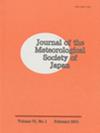南半球大气对平流层赤道准两年振荡(QBO)的响应
IF 1.6
4区 地球科学
Q3 METEOROLOGY & ATMOSPHERIC SCIENCES
引用次数: 7
摘要
研究了平流层赤道准两年振荡(QBO)对南半球冬季至初夏温带环流的影响。日本55年再分析(JRA-55)数据集用于1960-2010年。以平流层等效有效氯(EESC)、平流层中下层QBO、太阳周期、厄尔尼诺-南方涛动(ENSO)和火山气溶胶项为解释变量,通过多元线性回归确定了影响SH极涡纬向风变化的重要因素。结果表明,ENSO对SH极涡变化的贡献在SH初冬(6月)至隆冬(7月)是重要的,而平流层中期QBO对春季(9月至11月)至初夏(12月)的贡献是重要的。对平流层中下层QBO相关回归系数的分析表明,在季节演变中,从SH冬季到初夏,对SH极地涡旋都有影响。一种可能的途径是,中平流层QBO通过QBO诱导的平均经向环流导致SH低纬度平流层响应,从而导致高纬度响应。这有利于在QBO的西风阶段,从冬末(8月)到春季(9-11月),在高纬度(约60°S)的极地夜间急流(PNJ)延迟向下演变,从而在SH春季加强从平流层到对流层的西风。另一种可能的途径涉及对低平流层QBO的反应,该反应导致SH在冬末行星波向上传播的增加本文章由计算机程序翻译,如有差异,请以英文原文为准。
Response of the Southern Hemisphere Atmosphere to the Stratospheric Equatorial Quasi-Biennial Oscillation (QBO) from Winter to Early Summer
We investigate the effects of the stratospheric equatorial quasi-biennial oscillation (QBO) on the extratropical circulation in the Southern Hemisphere (SH) from SH winter to early summer. The Japanese 55-year Reanalysis (JRA-55) dataset is used for 1960 – 2010. The factors important for the variation of zonal wind of the SH polar vortex are identified via multiple linear regression, using equivalent effective stratospheric chlorine (EESC), middleand lower-stratospheric QBO, solar cycle, El Niño-Southern Oscillation (ENSO), and volcanic aerosol terms as explanatory variables. The results show that the contributions to the SH polar vortex variability of ENSO are important in SH early winter (June) to mid-winter (July), while that of middle-stratospheric QBO is important from spring (September to November) to early summer (December). Analyses of the regression coefficients associated with both middleand lower-stratospheric QBO suggest an influence on the SH polar vortex from SH winter through early summer in the seasonal evolution. One possible pathway is that the middle-stratospheric QBO results in the SH low latitudes stratospheric response through the QBO-induced mean meridional circulation, leading to a high-latitude response. This favors delayed downward evolution of the polar-night jet (PNJ) at high latitudes (around 60°S) from late winter (August) to spring (September–November) during the westerly phase of the QBO, consequently tending to strengthen westerly winds from stratosphere to troposphere in the SH spring. The other possible pathway involves the response to lowerstratospheric QBO that induces the SH late winter increase in upward propagation of planetary waves from the Journal of the Meteorological Society of Japan Vol. 96, No. 6 588
求助全文
通过发布文献求助,成功后即可免费获取论文全文。
去求助
来源期刊
CiteScore
6.70
自引率
16.10%
发文量
56
审稿时长
3 months
期刊介绍:
JMSJ publishes Articles and Notes and Correspondence that report novel scientific discoveries or technical developments that advance understanding in meteorology and related sciences. The journal’s broad scope includes meteorological observations, modeling, data assimilation, analyses, global and regional climate research, satellite remote sensing, chemistry and transport, and dynamic meteorology including geophysical fluid dynamics. In particular, JMSJ welcomes papers related to Asian monsoons, climate and mesoscale models, and numerical weather forecasts. Insightful and well-structured original Review Articles that describe the advances and challenges in meteorology and related sciences are also welcome.

 求助内容:
求助内容: 应助结果提醒方式:
应助结果提醒方式:


